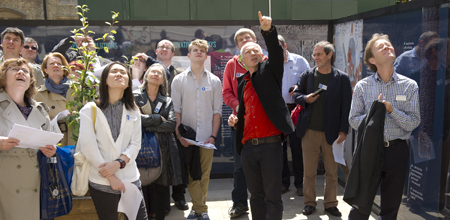'Maths in the City' Oxford walking tours begin 10 March
Did you know that the roof of the Sheldonian is held up by a piece of mathematics that Christopher Wren learnt while he was studying at Oxford? What is the influence of maths in the architecture of a building in St. John's College aptly named 'The Beehive'? And what does a wok, three sticks, and a bag of marbles got to do with maths in Oxford?
Join a tour in Oxford or London and discover answers to these questions and more. The first Oxford tours begin 10 March; book your place here: www.mathsinthecity.com/book
 Revealing the mathematics hiding in our urban surroundings is the purpose of a new phase of 'Maths in the City' - a public engagement project led by Marcus du Sautoy, the Charles Simonyi Professor for the Public Understanding of Science at the University of Oxford's Department for Continuing Education.
Revealing the mathematics hiding in our urban surroundings is the purpose of a new phase of 'Maths in the City' - a public engagement project led by Marcus du Sautoy, the Charles Simonyi Professor for the Public Understanding of Science at the University of Oxford's Department for Continuing Education.
The project involves the public in on-site walking tours in London and Oxford. It also highlights many fascinating examples of the mathematics in cities across the globe on a website that anyone can contribute to. See: www.mathsinthecity.com
Cities are filled with buildings, roads, cars, buses, trains, bikes, parks and gardens; crisscrossed with power, water, sewage and transport systems. They are built by engineers, architects, planners, doctors, designers and artists. Our cities are shaped by environment, society and culture. And each and every part is built on mathematics.
Professor Marcus du Sautoy has been working with his 'Mathmagicians', a team of volunteer students from Oxford, to develop walking tours of Oxford and London.
 Future tours are set to take place during the spring, they will be led by University of Oxford maths students and are open to all interested members of the public.
Future tours are set to take place during the spring, they will be led by University of Oxford maths students and are open to all interested members of the public.
The inaugural London tour on 21 February travelled from Tate Modern to St Paul's and explored the mathematical foundations of the architecture, networks, topology and resonance that are woven into the fabric of this corner of the capital. Read a review of this great day on 'The New Scientist' blog.
To find out more about the maths explored in this and future tours, or to book a place on a tour visit: www.mathsinthecity.com
Tour locations are described on the website along with other sites of mathematical interest from around the world. It is possible explore the tour routes and the maths involved online or to print a guide to the London and Oxford routes and walk them yourself.
Members of the public who have stories of maths in the city where they live are invited to create maths sites and tours for others to explore, by visiting the project website: www.mathsinthecity.com
Published 5 March 2012
